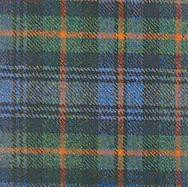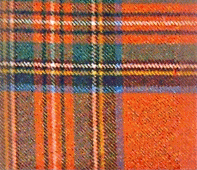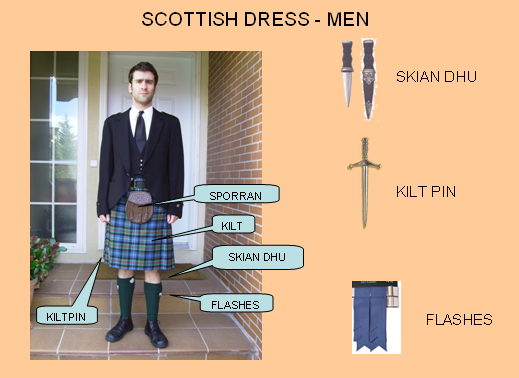Women
The tartan
BRING FORRIT THE TARTAN. As Sir Colin Campbell called to his Highland soldiers while they stormed a rebel fort in India in 1857.

The tartan is a type of cloth, usually made from wool, made up by intersecting woven lines of different colours and widths that form squares. There is no clearer symbol of Scottish identity. This is particularly so in reference to the Highland Clans and therefore to the kilt. Yet in fact, the word tartan is derived from the French – “tartaine” –which was a type of cloth.
 However, tartan descends from cloth made from the Gaelic “breacon” meaning “chequered”. In modern times tartan is often confused with plaid – in Gaelic “plaide”- , which means blanket or mantle. In reality, the plaid was a length of tartan that formed the ancient kilt: the “feileadh-mor” or “big wrap”. In spite of having existed since the time of the Picts – the tribes that in ancient times inhabited Scotland north of the Borderlands – tartan and the ancient kilt were not in popular use until the Seventeenth Century. It is said that the Scottish Army was responsible for tartan becoming a means of identification of the Highland Clans, and eventually of the whole Scottish nation. Highland dress and tartan later grew to popularity and extended beyond its origin throughout the country, without losing connection to the past. Thus, ancient setts or the combinations of woven colour, became more firmly associated with the clans. Further on in time, its use was extended to ordinary citizens.
However, tartan descends from cloth made from the Gaelic “breacon” meaning “chequered”. In modern times tartan is often confused with plaid – in Gaelic “plaide”- , which means blanket or mantle. In reality, the plaid was a length of tartan that formed the ancient kilt: the “feileadh-mor” or “big wrap”. In spite of having existed since the time of the Picts – the tribes that in ancient times inhabited Scotland north of the Borderlands – tartan and the ancient kilt were not in popular use until the Seventeenth Century. It is said that the Scottish Army was responsible for tartan becoming a means of identification of the Highland Clans, and eventually of the whole Scottish nation. Highland dress and tartan later grew to popularity and extended beyond its origin throughout the country, without losing connection to the past. Thus, ancient setts or the combinations of woven colour, became more firmly associated with the clans. Further on in time, its use was extended to ordinary citizens. The tartan is the only cloth to have been banned from use, on pain of death. It is now a potent symbol, not only of the highland Clans, but of all Scottish people and for the millions of their descendants spread throughout the world. It also contains the memory of the ancient clan system that was destroyed with the defeat of the Scottish Jacobites in 1754. Today, the popularity of Tartan is supported by its revival of the prospect of ancient lineage, because of its associations with the myths and legends of a stoic, proud and warlike people, and in its aesthetic attractiveness. New tartans are constantly being created. “The Scottish Tartans Society” and like entities work diligently to record all known tartans and their histories.
The tartan is the only cloth to have been banned from use, on pain of death. It is now a potent symbol, not only of the highland Clans, but of all Scottish people and for the millions of their descendants spread throughout the world. It also contains the memory of the ancient clan system that was destroyed with the defeat of the Scottish Jacobites in 1754. Today, the popularity of Tartan is supported by its revival of the prospect of ancient lineage, because of its associations with the myths and legends of a stoic, proud and warlike people, and in its aesthetic attractiveness. New tartans are constantly being created. “The Scottish Tartans Society” and like entities work diligently to record all known tartans and their histories.The Black Watch
Also known as The universal set, the 42nd or the Government tartan. The Black Watch tartan has the honour of being the first to be acknowledged as representing Scottish troops. And, of being the forerunner of many other tartans. Scottish troops raised to patrol the land after the Restoration of 1660 appear to have worn their own tartans without any regulation. The first Highland regiments raised at the end of the 17th C. wore, as did all other soldiers of those times, a simplified version of the clothing worn by gentlemen. Formalized Highland or Scottish military garb did not exist. Therefore, at the beginning of the 18th the Scots who enlisted in the British Army wore the standard British army uniform, while those Scots with allegiance to the Highland chiefs in rebellion against the House of Hanover wore an uncontrolled form of highland dress. So it is written that, at the Battle of Culloden, the MacDonalds had trouble distinguishing one branch of their clan from any other to be found fighting on the opposite side. However, after 1725 a form of highland military dress did emerge. With the formation of the six Highland Independent Companies, an effort was made to standardise all the tartans worn into one. In time, these independent companies joined together and became the 43rd regiment. Later to be known as the 42nd. And the Royal Highland Regiment or the Black Watch. Which tartans were used by the Independent Companies is still a matter of opinion. Certainly the Highland Regiments of 1739 all wore the Black Watch. After that, all units in the Highlands wore this same uniform, although they each added their own distinguishing details. It is curious to note that, although the Black Watch became the official tartan, it has no family associations.
Scottish troops raised to patrol the land after the Restoration of 1660 appear to have worn their own tartans without any regulation. The first Highland regiments raised at the end of the 17th C. wore, as did all other soldiers of those times, a simplified version of the clothing worn by gentlemen. Formalized Highland or Scottish military garb did not exist. Therefore, at the beginning of the 18th the Scots who enlisted in the British Army wore the standard British army uniform, while those Scots with allegiance to the Highland chiefs in rebellion against the House of Hanover wore an uncontrolled form of highland dress. So it is written that, at the Battle of Culloden, the MacDonalds had trouble distinguishing one branch of their clan from any other to be found fighting on the opposite side. However, after 1725 a form of highland military dress did emerge. With the formation of the six Highland Independent Companies, an effort was made to standardise all the tartans worn into one. In time, these independent companies joined together and became the 43rd regiment. Later to be known as the 42nd. And the Royal Highland Regiment or the Black Watch. Which tartans were used by the Independent Companies is still a matter of opinion. Certainly the Highland Regiments of 1739 all wore the Black Watch. After that, all units in the Highlands wore this same uniform, although they each added their own distinguishing details. It is curious to note that, although the Black Watch became the official tartan, it has no family associations.
After the Proscription of 1746, when all forms of Highland dress and even the playing of the bagpipes were banned, the Highland Regiments still in service continued to wear it. Over time, the Black Watch suffered modifications with the addition of other colours. And thereof gave forth to other tartans such as the Gordon tartan, with the addition of a yellow line. It is also worn, in lighter tones, as the Campbell Clan tartan and with modifications in other clans such as the Sutherlands, the Grants and the Munros. The 92nd Regimental tartan, the Mackenzie Lord McLeod’s 73rd Regimental tartan, the Loyal Clan Donnachie Volunteers tartan, the Mackenzies tartan and the Robertsons tartan all stem from the Black Watch.
The Black Watch owes its name to the patrols carried out against cattle thieves and marauders centuries ago. It is one of the three tartans that anyone who so desires may wear. Those Scots without a family tartan, or any individual who wishes to sport highland gear can wear it without further worries.
Fiona Pérez-Peterkin on behalf of the Schiehallion SCD Group


